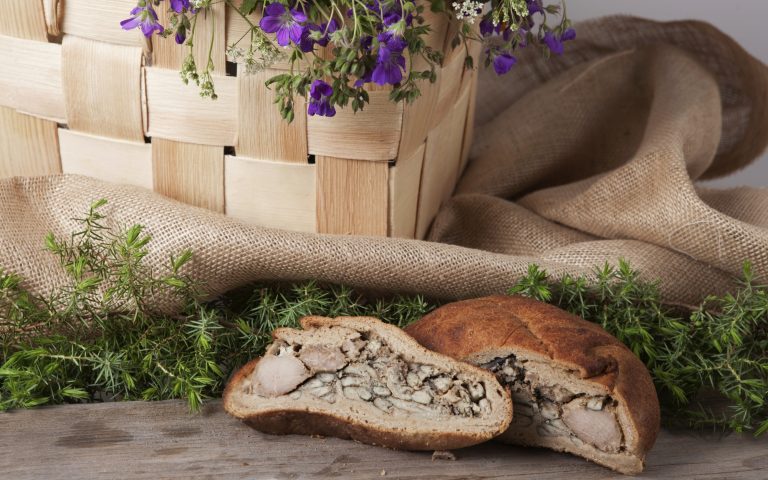Food was prepared in the masonry oven
Over the years Finnish cuisine has been influenced by both eastern and western traditions. In the prehistoric age Finland had two main human settlements: one in the east near Lake Ladoga, and another in the west in the Turku-Kokemäki area. The regions had very little contact with each other, and therefore two independent cuisines were formed.
In the east, food was prepared in the oven. This was a result of the architecture of the houses in eastern Finland. Every house had a big masonry oven that was used for heating the house as well as for cooking. In the gentle heat of the oven different pies, pasties, casseroles and stews were cooked. In eastern Finnish homes fresh bread was baked every week, whereas in the west bread was baked in large quantities a couple of times a year. Instead of the oven, the western homes preferred cooking on an open fire with a cauldron. Seafood and soups were commonly cooked. Because of the different cooking styles, the east was called ‘oven food area’ and the west ’soup food area’.
Finns also used to live in what was primarily a subsistence economy. Food was prepared from the ingredients that were available in a given season. The necessity to cook from the available ingredients formed Finnish regional delicacies. The differences between different regions have diminished during the time but regions still cherish their own traditional dishes with great pride.
Natural ingredients are the basis
Simple and pure natural ingredients are essential in Savonian cuisine. Savonian food culture has been influenced by southern and northern traditions. Southern Savonia is part of east’s oven food area where many dishes are prepared by slowly cooking them in the masonry oven.
Many lakes, all of which provide various different types of fish, surround the Savonia region. One of these fish is the Vendace, which is a local delicacy that can be enjoyed fried, cooked or as a filling of a pasty.
Another widely used ingredient is rye, which bakes rye bread and Finnish flatbread, rieska. Eastern Finnish rye bread is thicker and sourer than its western equivalent. Rye dough is also a key ingredient in a local dessert called rättänä – a rye dough covered pasty filled with juicy forest blueberries.
Savonia is known for its special pasties – kukko and lörtsy. Kukko is a pie baked in a thick rye bread crust. The most common filling is fish. Then the pie is called kalakukko. The Savonian kalakukko has obtained Traditional Speciality Guaranteed (TSG) status, other examples of which include Herefordshire Cider, Gorgonzola cheese and Champagne.
Lörtsy is a thin, half-moon shaped pastry that comes with variety of fillings. Most popular fillings are savoury meat filling and sweet apple mush filling. Best lörtsys can be bought from the local market.
Try kalakukko at home
Try out the local speciality kalakukko. Kalakukko is a hearty meal that is best enjoyed with a brush of butter on top and a glass of cold milk.
INGREDIENTS
Pastry
600ml water
4 tsp salt
150ml butter (melted)
450g wheat flour
370g rye flour
85g rye groats
Filling
700g of vendace fish
150g of bacon
2tsp salt
0.5tsp black pepper
To finish
150g melted butter
DIRECTIONS
- Preheat oven to 225 °C. To make the dough, stir in water, salt, melted butter and flour. Squeeze mixture until smooth. If necessary, add more rye flour. Roll the dough into a ball, press out flat on a floured surface and roll out into a round shape of 1.5–2 cm thickness in the middle and thinner around the edges.
- Sprinkle the middle of the dough with 2 tablespoons of rye flour and place a layer of vendace on top. Season with salt and pepper, and then place a layer of bacon on top of the vendace. Repeat until all fish and meat is gone. Moisten the edges of the dough with water. Slide your hands under the edges, lift the sides up and connect them at the top of the pie. Pinch the dough together in a seam along the top and sides to ensure it’s fully closed. Smooth the pie with a watered knife. Check that there are no cracks on the bottom of the pie. Apply more water to the pie surface and sprinkle over plenty of rye flour. Rub the flour into the pie’s surface.
- Lay baking parchment onto a baking tray, and place the pie on top. Bake at 225 °C for one hour, then moisten the surface with melted butter and lower the heat to 150 °C. Bake for approximately another four hours. Brush the surface with more melted butter at least every hour. Remove from oven and moisten the prepared fish pie once again. Wrap in foil and a cloth so that the rye shell softens and the fish pie continues to cook slowly in its residual heat. Serve with butter.
Explore more Savonian and Finnish traditional delicacies from Flavours of Finland map:
Flavours of Finland by ExpediaFI
Text: Iiris Lagus
Sources:
https://blogi.expedia.fi/makuja-suomesta/en/
http://www.aitojamakuja.fi/
http://www.ruokatieto.fi/
Picture: Visit Finland
Photographer: Vastavalo/Soili Jussila.








